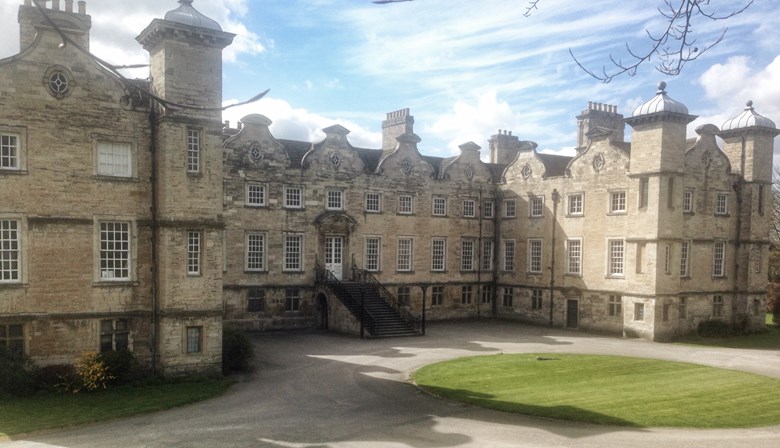Double Glazed Windows Permitted on Grade 1 Building – Ledston Hall
Posted: 28 April 2023

Ledston Hall, an enchanting country estate nestled in the picturesque Yorkshire countryside, has achieved a remarkable feat that sets it apart in British architectural history. Breaking new ground, Ledston Hall has become the first Grade I listed building in the UK to gain official approval for replacing its ageing single-glazed, metal-framed windows with state-of-the-art double-glazed alternatives. This momentous decision marks a significant step forward in preserving the building's heritage while embracing modern energy-efficient solutions.
Steeped in over seven centuries of history, Ledston Hall is presently undergoing a remarkable transformation under the care of the Wheler Foundation. This philanthropic trust, established by the visionary Wheler family two decades ago, is dedicated to safeguarding and restoring historically significant landmarks. Ledston Hall is a shining example of their commitment.
This ambitious renovation project aims to convert a portion of Ledston Hall into ten exquisite dwellings, each meticulously designed to harmonize contemporary comfort with timeless charm. Alongside the residential units, the restoration also encompasses communal rooms and meticulously landscaped gardens, ensuring a harmonious blend of privacy and shared spaces.
The recent authorisation granted to the Wheler Foundation to install double-glazed windows marks a watershed moment for Ledston Hall and the broader historical preservation community. By embracing innovative yet sensitive improvements, this Grade-I listed gem paves the way for other heritage buildings to embrace sustainable practices without compromising their intrinsic character. Ledston Hall's rich past has always been intertwined with progress, and this latest development continues that tradition.
Initially, the proposal to replace the windows faced scepticism. However, following a thorough review in 2020, the powers-that-be recognized the importance of balance between preservation and practicality. The restoration efforts have also involved meticulous repair work to retain the authenticity of the original windows, ensuring that their unique features endure for generations to come.
Once the transformation is complete and the apartments and houses are inhabited, the Wheler Foundation plans to welcome the public back to Ledston Hall's exquisite grounds. Open days and special events will allow visitors to immerse themselves in the historic ambience, revelling in this architectural masterpiece's grandeur and timeless beauty.
Historic buildings generally fall into two categories: Grade I-listed buildings and Grade II-listed buildings.
When a place is labelled as a listed building, it is immediately apparent that the building has historical value and is of some interest. However, many people need to be made aware of the specific difference between the two titles.
Even less know what this means for future renovations of listed historic buildings and whether the relevant permits need to be obtained.
Keeping that in mind, we've put together a handy guide to help you navigate and discover the value of a historic building.
There are many reasons why a building is registered as a historic monument. However, in general, the older the building, the more likely it is to be registered as a historic monument. The age of a building plays an essential role in its inscription as a historical monument. Because this, of course, shows its importance.
Buildings of historical, cultural or architectural interest or of national importance and considered worthy of protection are primarily protected monuments.
Similarly, all buildings built before 1700 and preserved in their original state, and most buildings constructed between 1700 and 1840 are listed. Generally, a building must be over 30 years old to be registered as historic. However, properties built after 1945 must be carefully inspected before being listed as historic buildings.
Perhaps surprisingly, it is currently unknown how many listed buildings there are in the UK. Because there are so many structures, it is challenging to count them all. It is also difficult to monitor totals, as entries often include several different buildings, such as annexes or rows of townhouses on large lots. However, Historic England now estimates there are around 500,000 buildings on the register.
How to Register a Building as a Registered Building
An individual can register a building as a Listed provided it meets specific criteria, which include historical, architectural, or cultural significance. Generally, buildings over 30 are eligible, but exceptions can be made for more recent structures. The individual will then need to research and gather information about the historical and architectural details of the building, including its age, construction style, notable features, and any relevant historical or cultural associations. This information will support the application.
The individual will then need to contact the local planning authority and complete an application for the process. It is advisable to speak to Historic England's team of experts to ensure there is a strong case for 'Listed Status'. Provided the application meets the necessary criteria, the building will then receive a 'Listed Status' and be graded as; Grade I, Grade II or GradeII*
What is a Designated Building?
A building is listed because its location is of extreme national, architectural, or historical importance. Category 1 listed buildings are rarely found compared to category 2 listed buildings simply because such sites are considered important.
Examples of buildings on the list include popular attractions such as Buckingham Palace, the Houses of Parliament and Tower Bridge. Only 2.5% of all buildings on the list fall into Category I.
What is a UK Listed Building?
Buildings registered in Category 2 fall into two categories. Most of these are marked as Category II, but a few buildings that are classified as of exceptional national importance or interest are marked as Category II*. The exact definition can be read here: https://historicengland.org.uk/advice/your-home/owning-historic-property/listed-building/
So What Exactly Does "Grade II" Mean?
Nearly 6% of all listed buildings are listed as Category II* buildings, and 92% are designated as Category II buildings simply because they are of particular architectural interest. Buildings and structures built before July 1, 1948, can be registered as historic monuments. Most of the homes listed fall into these categories. This means that if an owner wishes to renovate a historic building, it must obtain approval from the local government.
What Does Listed Building Mean?
Listing a building is important because it recognises its historical and cultural significance, but listing it prohibits alterations or requires that the building be preserved as it was at the time. Property owners apply for a building permit to make changes that may affect the building's appearance, structure, or historic design before undertaking work such as concrete restoration.
Therefore, a registered building should be celebrated for its rich history and heritage rather than standing still over time. They should be treated with the utmost care and respect, but that doesn't mean they can't be modified, enhanced, or repaired. Registration status is important, but other factors always play a role, such as the Function and Condition of Building - impact all decisions when submitting a planning application.
Listed Historic Building Renovation
Concrete Renovations specialises in renovation work for designated buildings nationwide. Buildings fall into different categories, but the planning process and how permits are obtained are similar.
In general, renovations should maintain the appearance and feel of the building and its surroundings. When performing concrete or masonry repairs, ensure that all surfaces are consistent in colour and texture.
The advisory process advises on the maintenance and repair of listed buildings. It provides all the information necessary to carry out quality repairs that preserve the building's original design and style.


















